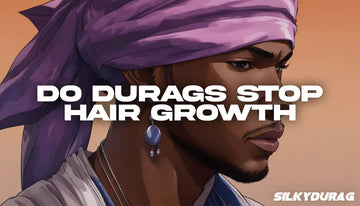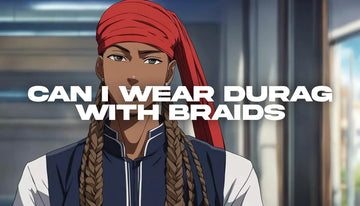Have you ever wondered whether wearing a durag can halt your hair growth progress? This comprehensive guide will explore the truth behind the question, "Do Durags Stop Hair Growth?"
Many individuals wear durags as an accessory to protect their hair, maintain certain hairstyles, or reduce friction that can cause breakage. However, some misconceptions surround durags and their impact on hair growth.
Whether you wear a durag at night to protect your hair or as a daily hair accessory, it's essential to understand how it can contribute to your hair's health. Keep reading to learn more about the role of durags, common misconceptions, potential benefits, and risks associated with wearing them.
Understanding Hair Growth
Before we can answer whether durags stop hair growth, it's crucial to understand how hair grows. Hair growth originates from hair follicles, small sacs beneath the scalp that produce hair strands.
The hair growth rate and quality differ among individuals and are heavily influenced by genetics, diet, and overall hair health. While some may experience rapid hair growth, others may experience slow growth or loss.
But fret not, promoting healthy hair growth is within reach! Adopting good hair habits can help stimulate new hair growth and make your hair thicker and healthier.
- Regular scalp massages to increase blood flow to hair follicles and promote hair growth
- Eating a diet rich in vitamins and minerals essential for healthy hair growth, such as biotin and Vitamin E
- Regular trimming of hair ends to avoid split ends and hair breakage
- Gentle hair washing and conditioning to maintain scalp and hair health
- Using natural hair care products and avoiding harsh chemicals that can damage hair
By incorporating these practices into your hair care routine, you can expect new hair growth and healthier hair overall. If you're curious about the role of headwear in promoting hair growth, don't miss our related article, 'Do Durags Help Hair Growth.'
The Role of Durags
Durags are often worn as a hair accessory, particularly by individuals with textured hair. They serve multiple purposes, including protecting the hair from damage, maintaining certain hairstyles, and reducing friction that can lead to hair breakage. Wearing a durag can help you protect your hair in certain styles, such as braids or twists. Durags are often worn at night to help preserve hairstyle overnight, but they can also be used during the day when you're out and about.
Durags prevent your hair from rubbing against harsh materials like cotton fabrics or even car headrests, which can damage the hair and cause breakage. They also protect hair from harsh weather conditions, such as wind, cold, and sun exposure, which can cause further damage or dryness.
For individuals with textured hair, maintaining moisture is essential. A durag can help lock in moisture and protect hair from becoming dry or brittle. This is especially important if you use heat tools or chemical treatments on your hair, as they can cause damage over time.

Durags are often worn for fashion or cultural reasons. They come in various colors and designs and can be worn as a statement piece or as a way to represent cultural identity. Wearing a durag can be a way to express yourself while protecting your hair.
Common Misconceptions
There are some misconceptions surrounding durags and their impact on hair growth. One common belief is that wearing a durag too tightly can suffocate the hair follicle and clog the scalp, leading to hair breakage or loss. This is not entirely accurate, as the tightness of a durag alone is unlikely to cause hair loss. However, it is important to be cautious when wearing a durag and avoid tying it too tightly, as this could contribute to hair breakage and damage.
Another misconception is that durags can cause hair loss. While durags do not directly cause hair loss, excessive wear or tying them too tightly can stress the hair strands and potentially contribute to hair breakage. Using durags correctly and maintaining a balanced hair care routine is essential to prevent damaging your hair.
Some people also believe that wearing a durag too often can cause your hair to become too reliant on it, leading to weaker hair over time. While no concrete evidence supports this idea, it's still vital to give your hair a break from wearing durags regularly, especially if you notice signs of hair damage or breakage. To delve deeper into this topic, check out our article 'Do Durags Cause Hair Loss.'
Tip: When wearing a durag, make sure to adjust it comfortably without tying it too tightly and avoid wearing it for extended periods. This will help to prevent damage and maintain healthy hair growth.
Potential Benefits of Using a Durag
If you're looking to help your hair grow and contribute to healthy hair, wearing a durag can be a valuable tool. While durags may not directly stimulate hair growth, they can indirectly support healthy hair practices. For example, wearing a durag can help protect your hair from external factors that can lead to damage, such as harsh weather conditions and UV radiation.
Additionally, by keeping your hair in place, durags can prevent tangling and breakage. This can help maintain your hair's overall health and reduce the likelihood of damage. Some individuals also find that using a hair treatment while wearing a durag can help promote healthy hair growth.
Overall, wearing a durag can be a beneficial hair accessory. By taking steps to protect and care for your hair, you can promote healthy hair growth and achieve the hair you've always wanted.
The Importance of Proper Usage
If you want to grow your hair, wearing a durag can help protect your hair at night. However, wearing a durag alone at night won't guarantee hair growth. The key to promoting healthy hair practices and growth is to use the durag correctly and consistently. It's recommended to wear a durag at night to maintain hairstyle and prevent damage caused by friction with pillows. Complementing durags with a healthy diet, regular washing, and conditioning will also contribute to optimal hair growth.
Whether or not durags are part of your hair care routine, following proper hair care practices is important. Keep your hair clean moisturized, and avoid excessive heat and chemical treatments that can damage your strands and potentially hinder its growth.

Remember to give your hair and scalp a break from wearing durags to allow it to breathe and avoid potential risks associated with excessive wear or tying them too tightly. Using a durag correctly and maintaining a balanced hair care routine can help promote healthy hair growth and protect it from external factors that can damage it.
Potential Risks and Precautions
While durags offer various benefits for hair health, it's also important to be aware of their potential risks.
Durags can cause hair breakage when tied too tightly or worn excessively. The constant tension on the hair strands can lead to hair breakage and damage. Therefore, it's essential to wear a durag comfortably without excessive tightness.
Durags may contribute to hair breakage when not used properly. When you remove a durag, be gentle and avoid pulling or tugging your hair.
Durags can lead to hair tangling and matting if left on for too long. Hair needs to breathe to remain healthy, and taking breaks from wearing durags is essential.
Always be mindful of the hair strands when using a durag. It's crucial to avoid pulling or tugging your hair when you remove the durag.
By being aware of these potential risks, you can take precautions to avoid damaging your hair while still enjoying the benefits of wearing a durag.
Conclusion
In conclusion, no evidence suggests that durags stop hair growth. However, they can provide various benefits, such as protecting your hair and promoting healthy hair practices. Using durags appropriately is essential, avoiding excessive tightness or prolonged wear, as this can stress the hair strands and possibly lead to hair breakage. Remember that durags can be a useful accessory, they are not a magic solution for hair growth.
You must maintain a healthy hair care routine that includes a balanced diet, regular washing, and conditioning to achieve optimal hair growth. Wearing a durag at night can help preserve your hairstyle and prevent damage caused by friction against your pillow.
The key takeaway is that wearing durags does not stop hair growth. They can provide indirect benefits contributing to healthy hair, but a balanced hair care routine is the foundation for promoting hair growth. So, wear your durag confidently, but remember to also take care of your hair.
FAQ
Q: Do durags stop hair growth?
A: No, durags do not stop hair growth. They are not known to hinder the natural growth process of hair.
Q: How does hair growth occur?
A: Hair growth occurs from hair follicles, small sacs beneath the scalp that produce hair strands. Factors like genetics, diet, and overall hair health can influence the rate of hair growth.
Q: Do durags directly stimulate hair growth?
A: No, durags do not directly stimulate hair growth. However, they can indirectly benefit hair health by protecting it from external factors like harsh weather conditions, UV radiation, and excessive friction.
Q: How should durags be used?
A: Durags are often worn at night to preserve hairstyles and prevent damage caused by friction with pillows. However, simply wearing a durag alone will not guarantee hair growth. Proper hair care, including a healthy diet and regular washing and conditioning, is also necessary.
Q: Are there any risks associated with wearing durags?
A: While durags do not directly cause hair loss, excessive wear or tying them too tightly can stress the hair strands and potentially contribute to hair breakage. Giving your hair and scalp regular breaks from wearing durags is important to allow them to breathe.









